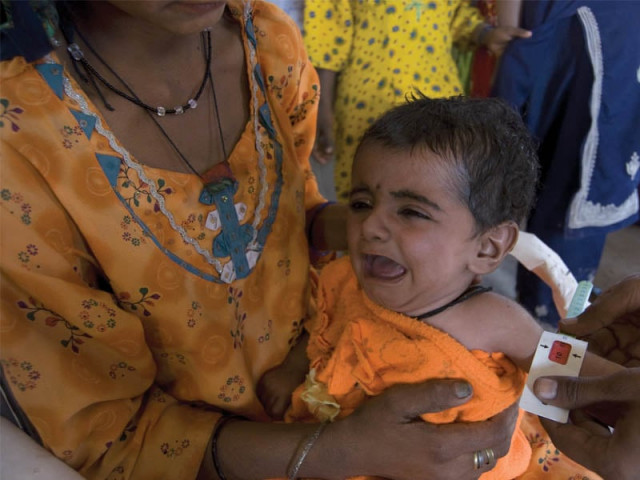In Badin, Pakistan’s most malnourished children rely on energy biscuits
Villagers say that the water is their biggest worry with the monsoon looming.

Pakistan has not slept more hungry than it does today. The torrential rains are over, the level of water in flood-hit areas has decreased, but the disaster is not history just yet. Its impact is still too strong, its traces too fresh on sickly faces of Sindh’s children.
The province’s worst-affected district, Badin, is still a haunting place. It cries of hunger. In a village of 300 households in union council Muhammad Khan Bhurgri there are 200 children under the age of five suffering from malnutrition. Pakistan’s next generation is being crippled.
Save the Children has set up mobile health centres in three union councils of Badin to monitor the problem. Health workers set weight targets and depending on the level of malnutrition, provide medication and energy biscuits and perform weekly and fortnightly check-ups for children under five.
Villagers say they are surviving on one meal a day. “Energy biscuits have helped, but we still need food,” a woman says.
While the emergency standard for malnutrition is 15 per cent, successive natural disasters have led to critical levels of malnutrition, up to 21 to 23 per cent, in the southern part of the province, according to the National Nutrition Survey 2011. The current percentage “is the worst condition of malnutrition in the world over the years,” the survey says.
“This is the highest percentage of malnutrition ever seen in Pakistan,” says a senior nutritionist from Save the Children, who requested not to be named because the organisation only allows its media adviser to officially speak to journalists.
Training sessions on breastfeeding are also held at the health centre. Some mothers here look as young as 13. “It is most essential to counsel mothers on breastfeeding to prevent malnutrition in children,” an official says.
Pakistan, India and Bangladesh have half of the world’s child population suffering from malnutrition, according to a report published by Save the Children.
But the primary concern of most people remains the standing water. “I have water up to my forehead,” says Khattu, a mother of seven pointing to her house at a distance. “Many children are ill here. When they are sick, they vomit in the water surrounding their house and it all stays there.” In some areas of the village there is up to four feet of water.
Other women join the conversation, nodding as Khattu, acting as a spokesperson, tells their story. “There are no employment opportunities here. Before the rains we had crops and a means of livelihood, but now it’s all gone,” she says.
She talks about the vicious cycle that now follows. “Since the crops are gone and the livestock has drowned, we have nothing to pay our debts. Our debts are mounting.”
The unprecedented torrential rains in Sindh broke a 60-year record last year, leaving three million people homeless and two million people food insecure. Last week, the United Nations and Pakistan appealed for an additional $440 million for flood-affected areas in Sindh and Balochistan.
“Even if it does not rain for the next five years, we will not be able to recover from the disaster,” says Janu, another woman from the village. After knowing that her story will be told in a newspaper, she says, “Just tell them about the water.”
With another monsoon season barely four months away, the standing water is a frightening sight. Last week, National Assembly Speaker Fehmida Mirza visited Badin for her son’s election campaign. Fehimda and her son Hasnain Mirza’s pictures adorned the streets of the city, looking down at their people from high billboards.
Published in The Express Tribune, March 2nd, 2012.



















COMMENTS
Comments are moderated and generally will be posted if they are on-topic and not abusive.
For more information, please see our Comments FAQ